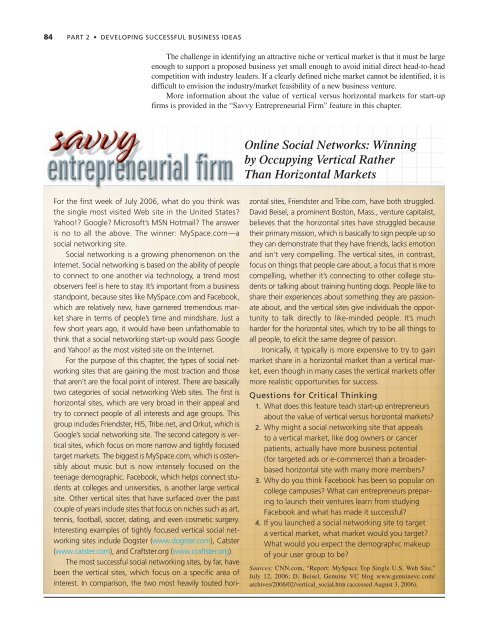feasibility analysis feasibility analysis
feasibility analysis feasibility analysis
feasibility analysis feasibility analysis
Create successful ePaper yourself
Turn your PDF publications into a flip-book with our unique Google optimized e-Paper software.
84 PART 2 • DEVELOPING SUCCESSFUL BUSINESS IDEAS<br />
The challenge in identifying an attractive niche or vertical market is that it must be large<br />
enough to support a proposed business yet small enough to avoid initial direct head-to-head<br />
competition with industry leaders. If a clearly defined niche market cannot be identified, it is<br />
difficult to envision the industry/market <strong>feasibility</strong> of a new business venture.<br />
More information about the value of vertical versus horizontal markets for start-up<br />
firms is provided in the “Savvy Entrepreneurial Firm” feature in this chapter.<br />
Online Social Networks: Winning<br />
by Occupying Vertical Rather<br />
Than Horizontal Markets<br />
For the first week of July 2006, what do you think was<br />
the single most visited Web site in the United States?<br />
Yahoo!? Google? Microsoft’s MSN Hotmail? The answer<br />
is no to all the above. The winner: MySpace.com—a<br />
social networking site.<br />
Social networking is a growing phenomenon on the<br />
Internet. Social networking is based on the ability of people<br />
to connect to one another via technology, a trend most<br />
observers feel is here to stay. It’s important from a business<br />
standpoint, because sites like MySpace.com and Facebook,<br />
which are relatively new, have garnered tremendous market<br />
share in terms of people’s time and mindshare. Just a<br />
few short years ago, it would have been unfathomable to<br />
think that a social networking start-up would pass Google<br />
and Yahoo! as the most visited site on the Internet.<br />
For the purpose of this chapter, the types of social networking<br />
sites that are gaining the most traction and those<br />
that aren’t are the focal point of interest. There are basically<br />
two categories of social networking Web sites. The first is<br />
horizontal sites, which are very broad in their appeal and<br />
try to connect people of all interests and age groups. This<br />
group includes Friendster, Hi5, Tribe.net, and Orkut, which is<br />
Google’s social networking site. The second category is vertical<br />
sites, which focus on more narrow and tightly focused<br />
target markets. The biggest is MySpace.com, which is ostensibly<br />
about music but is now intensely focused on the<br />
teenage demographic. Facebook, which helps connect students<br />
at colleges and universities, is another large vertical<br />
site. Other vertical sites that have surfaced over the past<br />
couple of years include sites that focus on niches such as art,<br />
tennis, football, soccer, dating, and even cosmetic surgery.<br />
Interesting examples of tightly focused vertical social networking<br />
sites include Dogster (www.dogster.com), Catster<br />
(www.catster.com), and Craftster.org (www.craftster.org).<br />
The most successful social networking sites, by far, have<br />
been the vertical sites, which focus on a specific area of<br />
interest. In comparison, the two most heavily touted horizontal<br />
sites, Friendster and Tribe.com, have both struggled.<br />
David Beisel, a prominent Boston, Mass., venture capitalist,<br />
believes that the horizontal sites have struggled because<br />
their primary mission, which is basically to sign people up so<br />
they can demonstrate that they have friends, lacks emotion<br />
and isn’t very compelling. The vertical sites, in contrast,<br />
focus on things that people care about, a focus that is more<br />
compelling, whether it’s connecting to other college students<br />
or talking about training hunting dogs. People like to<br />
share their experiences about something they are passionate<br />
about, and the vertical sites give individuals the opportunity<br />
to talk directly to like-minded people. It’s much<br />
harder for the horizontal sites, which try to be all things to<br />
all people, to elicit the same degree of passion.<br />
Ironically, it typically is more expensive to try to gain<br />
market share in a horizontal market than a vertical market,<br />
even though in many cases the vertical markets offer<br />
more realistic opportunities for success.<br />
Questions for Critical Thinking<br />
1. What does this feature teach start-up entrepreneurs<br />
about the value of vertical versus horizontal markets?<br />
2. Why might a social networking site that appeals<br />
to a vertical market, like dog owners or cancer<br />
patients, actually have more business potential<br />
(for targeted ads or e-commerce) than a broaderbased<br />
horizontal site with many more members?<br />
3. Why do you think Facebook has been so popular on<br />
college campuses? What can entrepreneurs preparing<br />
to launch their ventures learn from studying<br />
Facebook and what has made it successful?<br />
4. If you launched a social networking site to target<br />
a vertical market, what market would you target?<br />
What would you expect the demographic makeup<br />
of your user group to be?<br />
Sources: CNN.com, “Report: MySpace Top Single U.S. Web Site,”<br />
July 12, 2006; D. Beisel, Genuine VC blog www.genuinevc.com/<br />
archives/2006/02/vertical_social.htm (accessed August 3, 2006).

















